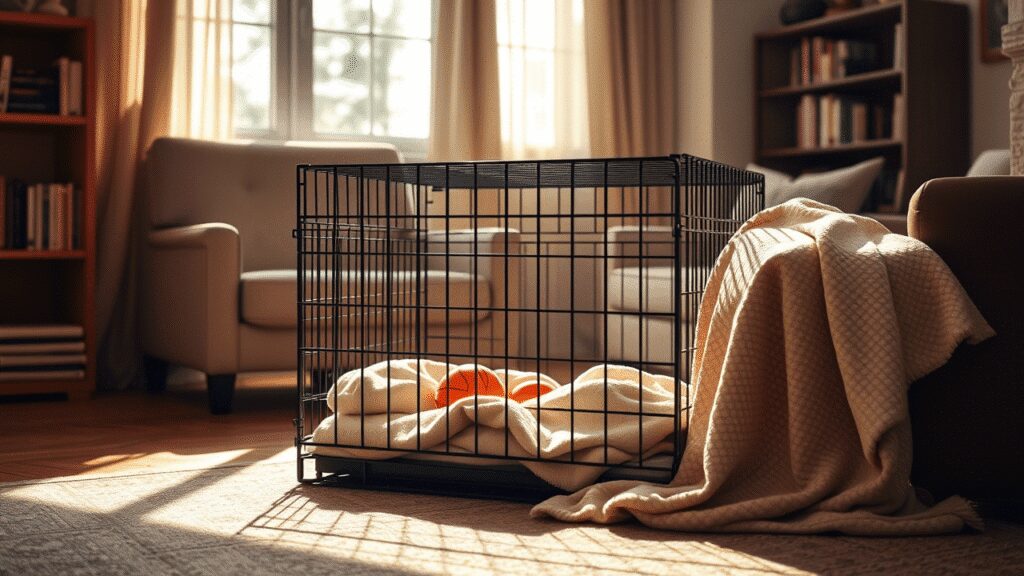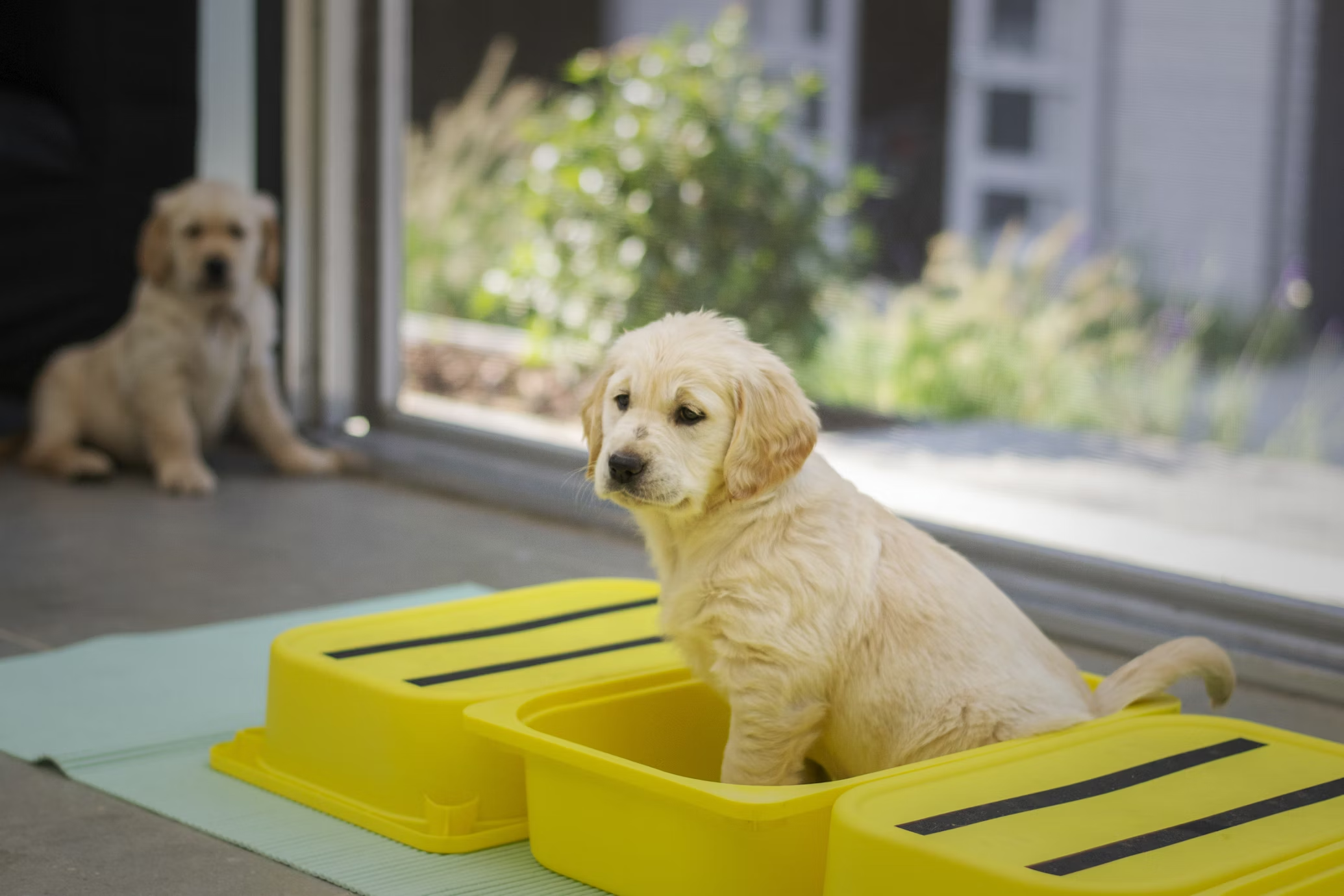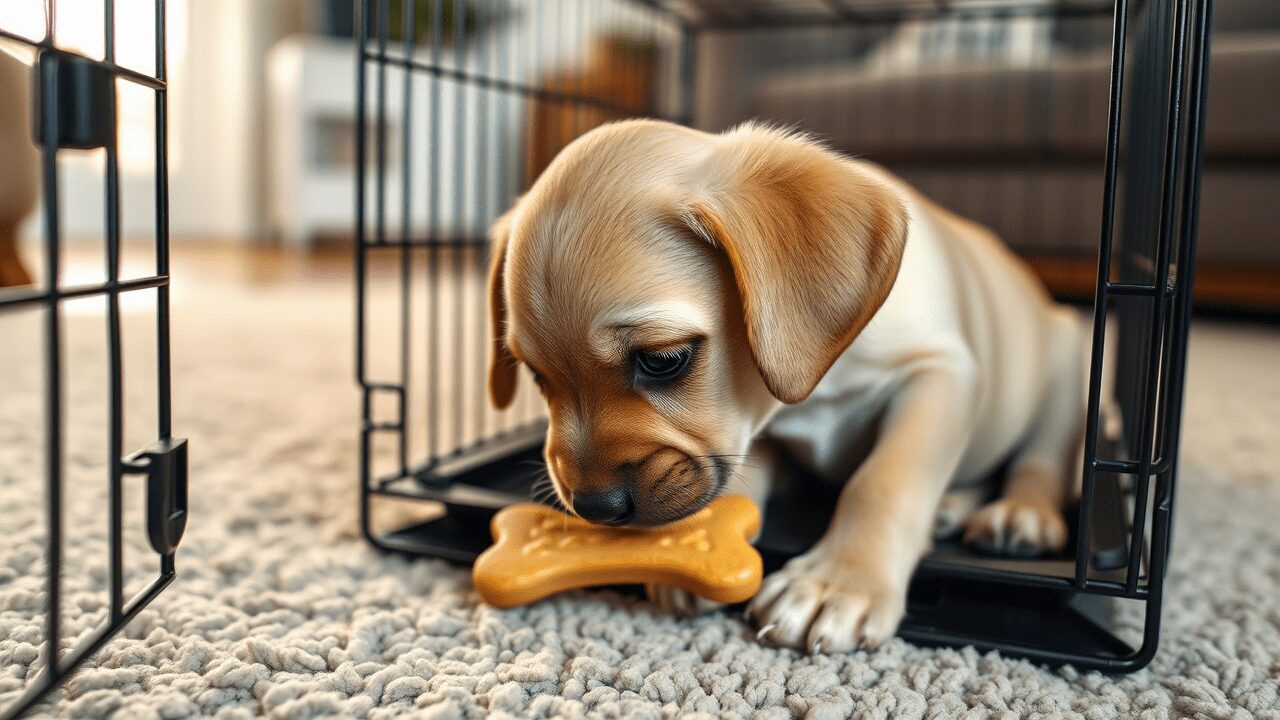So last year when I brought home my Lab mix, Cooper, I had zero clue how to create a crate training schedule for my puppy. Everyone kept telling me crate training was essential, but nobody gave me an actual crate training schedule for puppy development. After stumbling through those first few weeks (and plenty of 3 AM crying sessions), I finally worked out a crate training schedule for my puppy that worked.
I want to share my detailed crate training schedule for puppy owners so you don’t have to learn everything the hard way like I did. This schedule has been tested and refined through my own trial and error.
Contents
- 1 Creating an Effective Crate Training Schedule for Your Puppy
- 2 Setting Up Your Puppy’s Crate Training Environment
- 3 Week-By-Week Crate Training Schedule for Puppy
- 4 Daily Crate Training Schedule Template for Puppies
- 5 Troubleshooting Common Issues With Your Puppy’s Crate Training Schedule
- 6 Adapting Your Puppy’s Crate Training Schedule as They Grow
- 7 Crate Training Schedule for Puppy: Frequently Asked Questions
- 8 Conclusion
- 9 References
Creating an Effective Crate Training Schedule for Your Puppy
I originally thought crate training was just about keeping my furniture safe from puppy teeth. Boy, was I wrong. A proper crate training schedule for puppies does so much more than protect your belongings.
Puppies need structure and routine, especially after leaving their littermates. A consistent crate training schedule for puppy development helps them feel secure in their new environment. Following a reliable crate training schedule for a puppy can make the difference between chaos and calm in those early weeks.
Some major benefits I noticed from following a proper crate training schedule for my puppy:
- Cooper was fully house-trained by 14 weeks (much faster than my previous dog)
- His separation anxiety decreased dramatically
- My shoes and furniture survived the puppy stage
- We both started getting decent sleep
- Car trips became easier since his crate became his portable safe space
Setting Up Your Puppy’s Crate Training Environment

Before diving into the actual crate training schedule for puppy success, let’s get the basics right. Setting up the proper environment is crucial for any effective crate training schedule for puppy.
Selecting the Right Crate for Your Puppy’s Training Schedule
This was my first mistake with Cooper’s crate training schedule. I bought a massive crate thinking he needed space. Wrong move for a puppy!
For an effective crate training schedule, your puppy’s crate should be just big enough for them to stand up, turn around, and lie down. Too much space and they’ll use one corner as a bathroom (yep, learned that lesson the hard way during week one of our crate training schedule).
For most puppies, get an adjustable crate with dividers you can move as they grow. This was a game-changer for our crate training schedule once I figured it out.

Creating a Positive Environment for Your Puppy’s Crate Training Schedule
The crate should be a happy place, not a punishment zone. For your puppy’s crate training schedule to succeed, make their crate inviting:
- Put something soft but washable inside (accidents happen during crate training)
- Add a safe toy they can have during crate time
- Cover part of the crate with a blanket to create a den-like feeling
- Place it somewhere quiet but not isolated from family activity
When I first brought Cooper home, I put his crate in the guest bedroom. His crying nearly drove me insane. Moving it to the corner of the living room made a huge difference in our crate training schedule success.
Week-By-Week Crate Training Schedule for Puppy
Week 1: Introduction Phase of Your Puppy’s Crate Training Schedule

The first week of your crate training schedule for puppy adaptation is crucial—it sets the foundation for everything. This initial phase of the crate training schedule for puppies requires patience and consistency.
Days 1-2: Crate Introduction
- Keep the door open at all times
- Randomly toss treats near and then inside the crate
- Feed meals closer and closer to the crate, eventually inside it
- Never force your puppy inside—patience is key to your crate training schedule
Days 3-5: Short Duration Training
- Begin closing the door for very brief periods—30 seconds to 2 minutes
- Give treats ONLY when they enter voluntarily
- Use a consistent command like “crate up” or “bed time”
- Open before they start showing distress
Days 6-7: Extended Crate Practice
- Work up to 5-10 minutes with door closed
- Start moving around the room while they’re crated
- Practice 3-5 times daily as part of your puppy’s crate training schedule
I nearly derailed our entire crate training schedule on day 4 when Cooper whined and I immediately let him out. He quickly learned crying = freedom. I had to reset our crate training schedule and start over.
Week 2: Building Duration in Your Puppy’s Crate Training Schedule
Now that your puppy is familiar with the crate, your crate training schedule for puppy comfort can include longer periods. This second week in your crate training schedule for puppies builds on the foundation you established.
Days 8-10: Alone Time Practice
- Give them something awesome like a Kong with peanut butter
- Leave the room briefly—start with just a minute or two
- Gradually extend to 10-15 minutes in the crate
- Don’t make dramatic goodbyes or hellos—keep it casual
Days 11-14: Establishing a Regular Crate Training Schedule
- Start crating after playtime when they’re naturally tired
- Begin overnight crating (with appropriate potty breaks)
- Mix in random daytime crate sessions of 30-60 minutes
One thing that really helped our crate training schedule—I put on some background noise. Not necessarily fancy “dog calming music,” just a talk radio station so Cooper didn’t feel alone in a silent house.
Week 3-4: Extending Your Puppy’s Crate Training Schedule
By week 3 of your crate training schedule for puppy development, they should be getting more comfortable. These later weeks in your crate training schedule for puppies focus on extending duration and normalizing the crate as part of daily life.
Week 3:
- Schedule regular crate naps—about 1-2 hours, twice daily
- Practice actual departures from the house
- Crate them occasionally even when you’re home
Week 4:
- Extend to 3-4 hour maximum periods for older puppies
- Keep the overnight routine consistent in your crate training schedule
- Start crating during potentially chaotic times (dinner guests, etc.)
Daily Crate Training Schedule Template for Puppies
After the initial training phases, here’s a comprehensive daily crate training schedule for puppies that worked for Cooper and me. This crate training schedule for puppy owners can be adapted to your specific situation:
| Time | Activity | Duration | Notes |
|---|---|---|---|
| 6:30 AM | Potty break | 5 min | Straight outside, no playing |
| 6:45 AM | Breakfast | 15 min | Fed in crate with door open |
| 7:00 AM | Potty again | 5 min | Key part of puppy crate training schedule |
| 7:15 AM | Play/Train | 30-45 min | Burn some energy |
| 8:00 AM | Potty break | 5 min | Always before crate time |
| 8:15 AM | Crate time | 1-2 hrs | Morning nap with frozen Kong |
| 10:00 AM | Potty & play | 30 min | Quick exercise session |
| 10:30 AM | Crate time | 1-2 hrs | More napping (puppies sleep a lot) |
| 12:30 PM | Lunch & potty | 30 min | Small meal, big potty chance |
| 1:00 PM | Play/Training | 30 min | Mental games tire puppies quickly |
| 1:30 PM | Potty break | 5 min | The pre-crate ritual |
| 1:45 PM | Crate time | 2-3 hrs | Afternoon crate session |
| 4:30 PM | Potty & exercise | 45-60 min | Longer play session |
| 5:30 PM | Dinner | 15 min | In crate if possible |
| 5:45 PM | Potty break | 5 min | Prevent evening accidents |
| 6:00 PM | Family time | 2-3 hrs | Supervised free time |
| 8:30 PM | Final potty | 10 min | Essential for overnight crating |
| 9:00 PM | Bedtime in crate | 8 hrs | With night potty breaks as needed |
Your times will probably differ based on your work schedule and your puppy’s age. The pattern matters more than the exact clock times in your crate training schedule for puppies.
Troubleshooting Common Issues With Your Puppy’s Crate Training Schedule
Whining and Barking During Crate Training
The soundtrack of my first week implementing Cooper’s crate training schedule for puppy adjustment. If your puppy won’t stop crying while following your crate training schedule for puppies:
- Double-check they’ve had enough exercise and potty time
- Don’t give in during crying—wait for even 5 seconds of quiet
- Try covering more of the crate
- Move the crate closer to your bed at night
This sounds weird, but I put my old unwashed gym shirt in Cooper’s crate during training. The smell of me helped him settle. Gross but effective for our crate training schedule.
Puppy Reluctant to Enter the Crate
If your puppy resists your crate training schedule by refusing to go in:
- Never drag them in—you’ll undo all your crate training work
- Use better treats (I had to upgrade to bits of chicken)
- Make the crate the only place they get meals
- Try tossing a favorite toy inside as a lure
Accidents During Your Puppy’s Crate Training Schedule
Finding a puddle in the crate? Check these issues in your crate training schedule:
- Crate might be too big
- Schedule might need more frequent breaks
- Puppy might be too young for the duration
- Possible UTI or other health issue
Cooper kept having accidents until I realized my 9-week-old puppy simply couldn’t hold it for 3 hours yet, no matter what the “one hour per month of age” rule said. I had to adjust our crate training schedule accordingly.
Adapting Your Puppy’s Crate Training Schedule as They Grow
Your crate training schedule for puppy development will need adjustments as your pup gets older. A good crate training schedule for puppies evolves with their age and developing bladder control:
- 8-10 weeks: Max 1-2 hours in crate daytime, nighttime potty every 2-3 hours
- 11-14 weeks: Max 2-3 hours daytime, maybe one middle-of-night potty break
- 15-16 weeks: Up to 3-4 hours daytime, might sleep through the night
- 17+ weeks: 4-5 hours max daytime, usually good overnight
Cooper’s now 14 months old and honestly still spends time in his crate when I’m at work. The funny thing is, he goes in there on his own when he wants peace and quiet. That’s how I know our crate training schedule was successful!
Crate Training Schedule for Puppy: Frequently Asked Questions
How long can my puppy stay in a crate during the day?
The old rule for a puppy’s crate training schedule is one hour per month of age, plus one. So a 3-month-old puppy shouldn’t be crated longer than about 4 hours max. But honestly, even that felt too long for Cooper at that age. I hired a dog walker to break up longer days.
Should I include water in my puppy’s crate during training?
For short periods in your crate training schedule, no need. For longer stretches, maybe a small spill-proof bowl. I took water away about 2 hours before bedtime, which helped with overnight accidents during crate training.
My puppy cries all night in the crate despite following a training schedule. What should I do?
Been there! Make sure they’re tired, had a potty break, and the crate is comfortable. Put the crate right next to your bed initially so they can sense you. If they wake crying, take them directly to potty with minimal interaction, then right back to crate. And maybe invest in earplugs for a few nights while your puppy adjusts to the crate training schedule.
Can I use a crate as punishment in my puppy’s training schedule?
Absolutely not. The crate needs to be their happy place for a successful crate training schedule. Using it as punishment will make them hate it, and you’ll be back to square one (or worse).
Conclusion
Not gonna lie—implementing a crate training schedule for puppy training tests your patience. There were nights I questioned all my life choices while listening to Cooper whine at 3 AM. But stick with a consistent crate training schedule for puppies, and within a few weeks, most puppies adapt well.
Remember that crate training isn’t about confining your dog—it’s about creating a safe space your dog actually wants to be in. Every puppy is different, and you’ll probably need to tweak this crate training schedule for puppy success based on your particular dog’s personality.
The best advice I can give? Trust the process, be patient with setbacks (there will be many), and know that this tough phase is temporary. Soon enough, following your crate training schedule for puppies will pay off, and “crate time” will just be another normal part of your puppy’s day.
